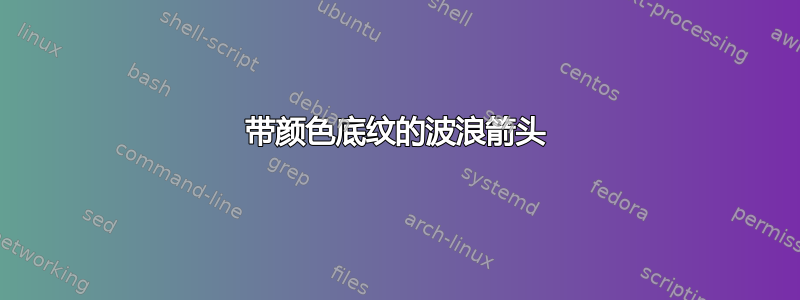
我想创建一个波浪箭头,波浪上有颜色渐变。为此,我尝试结合以下解决方案:https://tex.stackexchange.com/a/197867/96546获得颜色渐变的解决方案https://tex.stackexchange.com/a/193451/96546表示波浪箭头。
以下是 MWE:
\documentclass[tikz, border=5]{standalone}
\usetikzlibrary{shapes.arrows}
\makeatletter
\def\createshadingfromlist#1#2#3{%
\pgfutil@tempcnta=0\relax
\pgfutil@for\pgf@tmp:={#3}\do{\advance\pgfutil@tempcnta by1}%
\ifnum\pgfutil@tempcnta=1\relax%
\edef\pgf@spec{color(0)=(#3);color(100)=(#3)}%
\else%
\pgfmathparse{50/(\pgfutil@tempcnta-1)}\let\pgf@step=\pgfmathresult%
%
\pgfutil@tempcntb=1\relax%
\pgfutil@for\pgf@tmp:={#3}\do{%
\ifnum\pgfutil@tempcntb=1\relax%
\edef\pgf@spec{color(0)=(\pgf@tmp);color(25)=(\pgf@tmp)}%
\else%
\ifnum\pgfutil@tempcntb<\pgfutil@tempcnta\relax%
\pgfmathparse{25+\pgf@step/4+(\pgfutil@tempcntb-1)*\pgf@step}%
\edef\pgf@spec{\pgf@spec;color(\pgfmathresult)=(\pgf@tmp)}%
\else%
\edef\pgf@spec{\pgf@spec;color(75)=(\pgf@tmp);color(100)=(\pgf@tmp)}%
\fi%
\fi%
\advance\pgfutil@tempcntb by1\relax%
}%
\fi%
\csname pgfdeclare#2shading\endcsname{#1}{100}\pgf@spec%
}
\createshadingfromlist{shading1}{vertical}{red,yellow,green,cyan,blue}
\createshadingfromlist{shading2}{vertical}{red,yellow}
\createshadingfromlist{shading3}{vertical}{black,blue,cyan,white}
%%%
\usetikzlibrary{decorations.shapes}
\usetikzlibrary{shapes.geometric, arrows}
\usetikzlibrary{patterns}
\usepackage[compat=1.0.0]{tikz-feynman}
\usetikzlibrary{decorations.pathreplacing,angles,quotes,decorations.pathmorphing}
\usepackage{tkz-euclide}
%\usetkzobj{all}
\usepackage{pgfplots}
\pgfplotsset{compat=1.9}
\begin{document}
\tikzset{decorate sep/.style 2 args=
{decorate,decoration={shape backgrounds,shape=circle,shape size=#1,shape sep=#2}}}
\begin{tikzpicture}[colorbar arrow/.style={
shape=double arrow,
double arrow head extend=0.125cm,
shape border rotate=90,
minimum height=5cm,
shading=#1
},
wavy/.style={decorate,decoration={snake,post length=1.2mm}}
]
\node [colorbar arrow=shading1,wavy] at (0,0) {};
% \node [colorbar arrow=shading2] at (1,0) {};
% \node [colorbar arrow=shading3] at (2,0) {};
\end{tikzpicture}
\end{document}
所以它几乎可以正常工作,但不知何故,末端不再是真正的箭头,并且波会修改箭头边界的两侧。我想创建的是类似
带有颜色渐变。这可以在上面的 MWE 中通过将\node行替换为\draw[red,wavy,->,>=stealth'] (5.0,0.2) -- (2.2,0.2) node [above] {};
对于这种组合中出现了什么问题或如何正确进行的任何提示,我们深表感谢!
答案1
我提出的解决方案是通过循环和 sin 函数同时实现波浪路径和颜色变化;不涉及任何装饰。
箭头是一个pic对象,w arrow取决于六个参数:起点和终点、“波”的振幅、(完整)周期数、起始和结束颜色。
评论。如果您需要两种以上颜色的渐变,则必须以列表形式提供颜色。修改很少。如果您需要,我们可以讨论。
代码
\documentclass[margin=10pt]{standalone}
\usepackage{tikz}
\usetikzlibrary{math, calc}
\tikzset{%
pics/w arrow/.style args={from=#1 to=#2, amplitude=#3, periods=#4,
s-color=#5, e-color=#6%
}{%
code={%
\tikzmath{%
integer \nbSteps, \i, \j;
real \d, \r, \angle, \nbPeriods, \h, \ecst, \acst;
coordinate \S, \E;
\nbPeriods = #4 +.75;
\nbSteps = 25;
\S = #1;
\E = #2;
\d = veclen(\Ex-\Sx, \Ey-\Sy)*1pt/1cm;
\acst = .65; % controls the horizontal segment supporting the arrow
\r = \d/(\nbPeriods +\acst);
\ecst = (\nbPeriods +.3)/(\nbPeriods +\acst);
\angle = atan2(\Ey-\Sy, \Ex-\Sx);
\h = \nbPeriods/\nbSteps; % domain length for \x
\a = 0;
\b = \a +\h;
for \i in {1,...,\nbSteps}{%
\j = 4*\i;
{%
\draw[#6!\j!#5, line cap=round,
domain=\a:\b, samples=15, shift={(\S)}, rotate=\angle]
plot ({\r*\x}, {-#3*sin(360*\x)});
};
\a = \b;
\b = \a +\h;
};
{%
\path[shift={(\S)}, rotate=\angle]
({\r*\nbPeriods}, {-#3*sin(360*\nbPeriods)})
coordinate (tmpPoint);
\draw[#6, ->] (tmpPoint)
to[out=\angle, in=\angle+180] ($(\S)!\ecst!(\E)$) -- (\E);
};
}
}
}
}
\begin{document}
\begin{tikzpicture}[]
\draw[fill=gray!20] (0, 0) circle (1.5pt) node[left] {$S$};
\draw[fill=gray!20] (3, 1) circle (1.5pt) node[right] {$E$};
\path pic[very thick]
{w arrow={from=(0, 0) to=(3, 1), amplitude=.2, periods=3,
s-color=green, e-color=blue}};
\path pic[]
{w arrow={from=(0, -.5) to=(4, -.5), amplitude=.1, periods=5,
s-color=cyan, e-color=red}};
\path pic[line width=4pt]
{w arrow={from=(0, -.5) to=(4, -3), amplitude=.3, periods=2,
s-color=cyan, e-color=violet}};
\end{tikzpicture}
\end{document}





